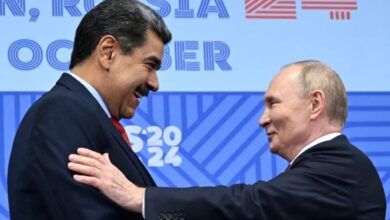Tensions Between Russia and Ukraine: What Are Putin’s Interests?
Tension on the border between Russia and Ukraine begins to escalate to the point of talk of a possible war. How far will President Putin's interests go with his neighboring nation? .

The end of the year has been marked by tensions between Russia and Ukraine once again, although this time they are at their highest point in years due to the mobilization of Russian troops towards the border. Photo: Press Service of the President of the Russian Federation
LatinAmerican Post | Yolanda González Madrid
Listen to this article
Leer en español: Tensión Rusia y Ucrania: ¿Cuáles son los intereses de Putin?
The end of the year has been marked by tensions between Russia and Ukraine once again, although this time they are at their highest point in years due to the mobilization of Russian troops towards the border, something that has fueled fear of a possible war in eastern Europe. In recent days, intelligence officials of the United States warned NATO that Russia had concentrated approximately 175,000 soldiers near Ukrainian territory and that they would be in a position to invade said country in the coming months. But is there really an invasion threat?
On the one hand, Ukraine affirms that Russia intends to destabilize the country prior to a military invasion. Given this, the Western powers warned the Putin government not to carry out more aggressive movements on the border to avoid a possible war. However, in the Kremlin they flatly deny that they have a plan to attack Ukrainian territory and argue that NATO's support for Ukraine is a growing threat on the western side of Russia. Regardless of who is right, the picture looks increasingly difficult for both nations.
It is important to mention that many of the Russian military bases are located on the west side of the nation, since a possible threat to the country is more likely to arrive from there. That is why the Ministry of Defense of that nation announced at the beginning of December that they would carry out regular winter military exercises in its southern region, a scenario that alerted the United States and NATO to the "unusual" movements of Russian material. (self-propelled guns, battle tanks and infantry fighting vehicles) just 300 kilometers from the border.
A historical conflict with precedent
Tensions between Russia and Ukraine began to intensify in 2013, when then-Ukrainian President Víktor Yanukovych decided not to continue with the talks on the political and trade agreement he had with the European Union, resulting in a series of violent protests in the city from Kiev. A year later, the spotlight fell on Crimea, a peninsula that once belonged to Russia until the Soviet Union transferred it to Ukraine in 1954. What very few knew is that it was a strategically important area for Russian control of the Black Sea.
Things came to a head in 2014 when Russian forces invaded the Crimean region of Ukraine with little fighting, this on the pretext that they were defending the interests of Russian-speaking citizens in the region. Along with this situation, Russia attacked the eastern region of Ukraine, specifically Donbas, with the intention of separating it and unifying it with its territory. Days later, the Putin government completed the annexation of Crimea with a referendum that was dismissed as illegitimate by Ukraine, while pro-Russian separatists in Donbas declared their independence from Kiev, which ended up sparking months of intense fighting.
You may also be interested in: Opinion: The Hypocrisy of the Summit for Democracy in the United States
Later, in 2015, Ukraine and Russia signed a peace agreement in Minsk with the mediation of France and Germany, although this has not stopped the repeated violations of the ceasefire. On the other hand, discontent with the Ukrainian opposition over what happened in 2013 with former President Yanukovych, made the eastern region of Ukraine feel more affinity for Russia and therefore allow easy access for its troops. In fact, historically these areas have been characterized by having a strong Russian influence on their citizens since their separation from the USSR.
What does Putin want and what factors are at play?
At the time, President Putin warned the West not to cross Russia's "red lines" on Ukraine. In other words, what he was looking for was to stop NATO's expansion to eastern Europe so that they could deploy weapons in countries that would pose a threat to the Russian nation, and it is that one of the most hostile situations to which they have made Emphasis is on the deployment of Turkish drones by Ukraine against Russian-backed forces in eastern Ukraine, not forgetting that the Minsk peace agreement remains far from being fulfilled.
On the other hand, an important factor that also comes into play revolves around the supply of energy. Russia has a gas pipeline (Nord Stream 2) that connects the Russian gas supply directly with Germany and which has a terrestrial network that crosses eastern Europe, including Ukraine. That is why Kiev considers that these gas pipelines serve as protection against a possible Russian invasion, since they could interrupt the flow of gas to the rest of Europe.
In short, Putin's interest in Ukraine would be both economic and territorial. Its geopolitical pretensions generate great challenges for the Ukrainian nation, as Russia seeks to assert itself and establish itself in its former area of influence. The conquest of geopolitical spaces by the Russian government makes it a global actor capable of generating a counterweight to its main rivals, where Ukraine represents the link to measure the forces between the West and Moscow.





